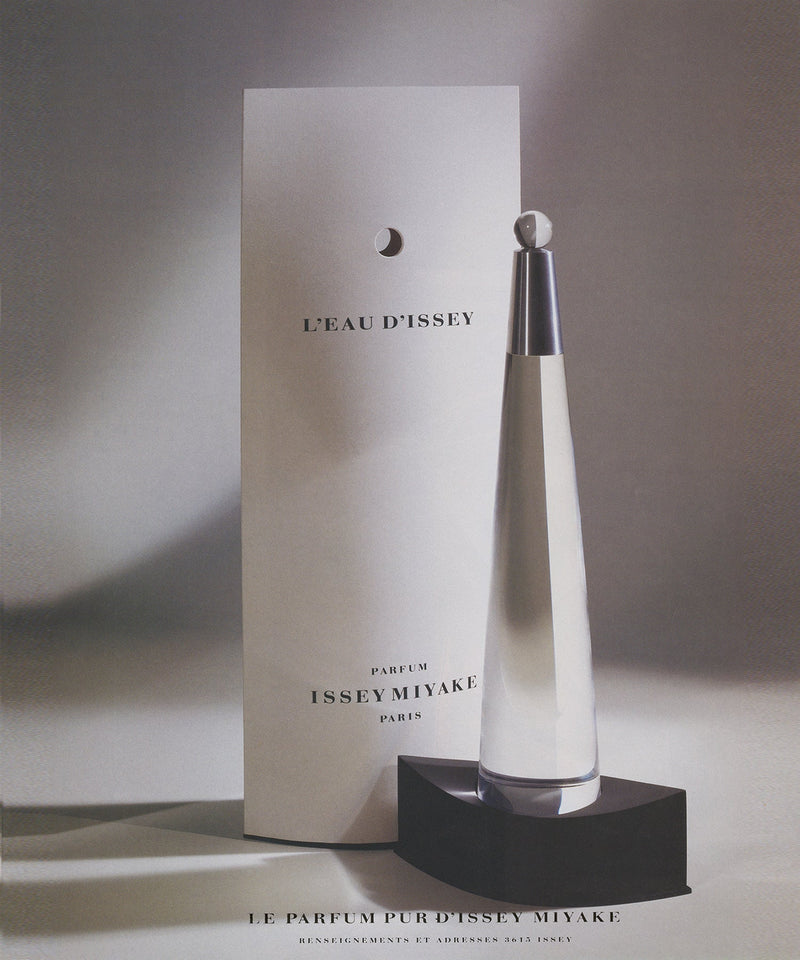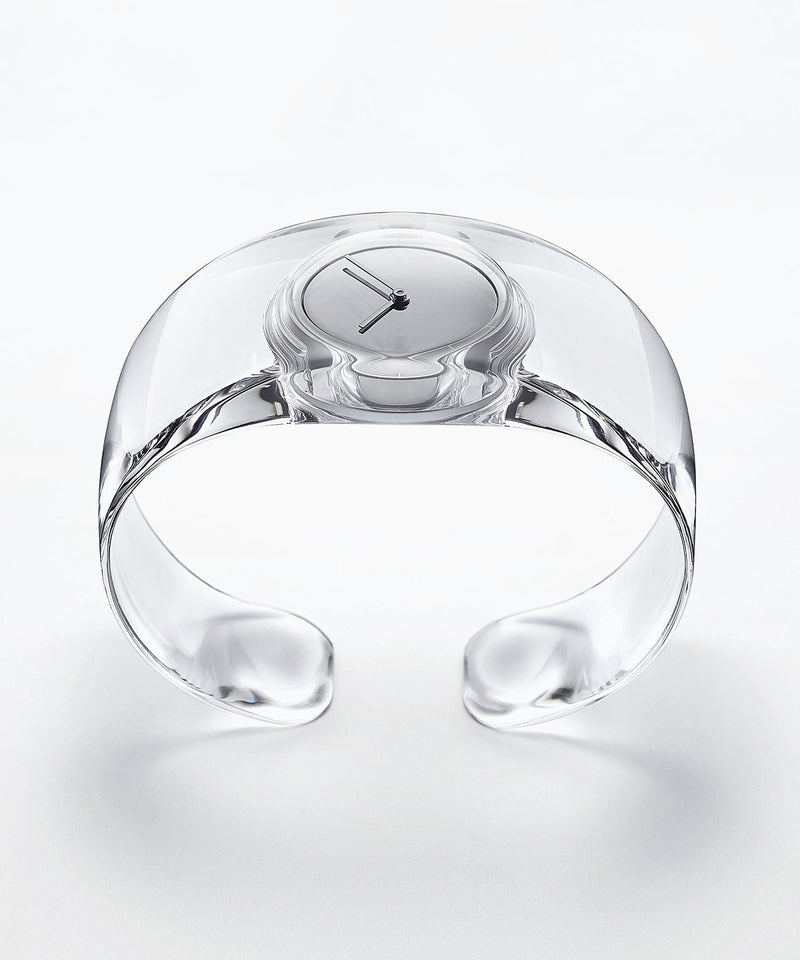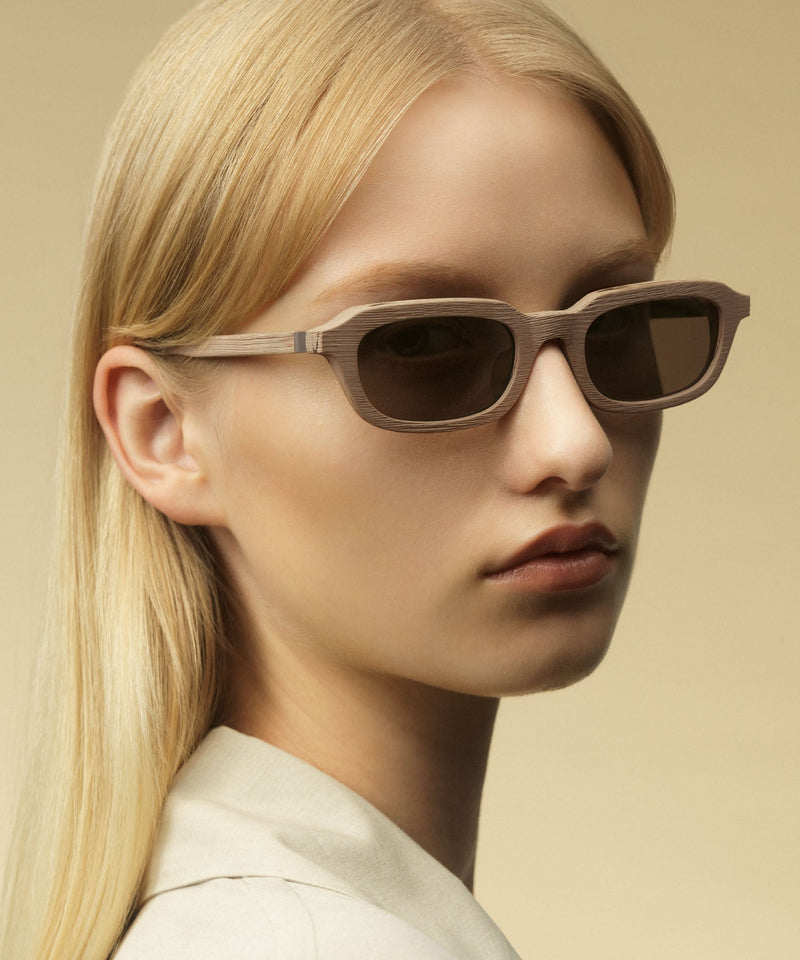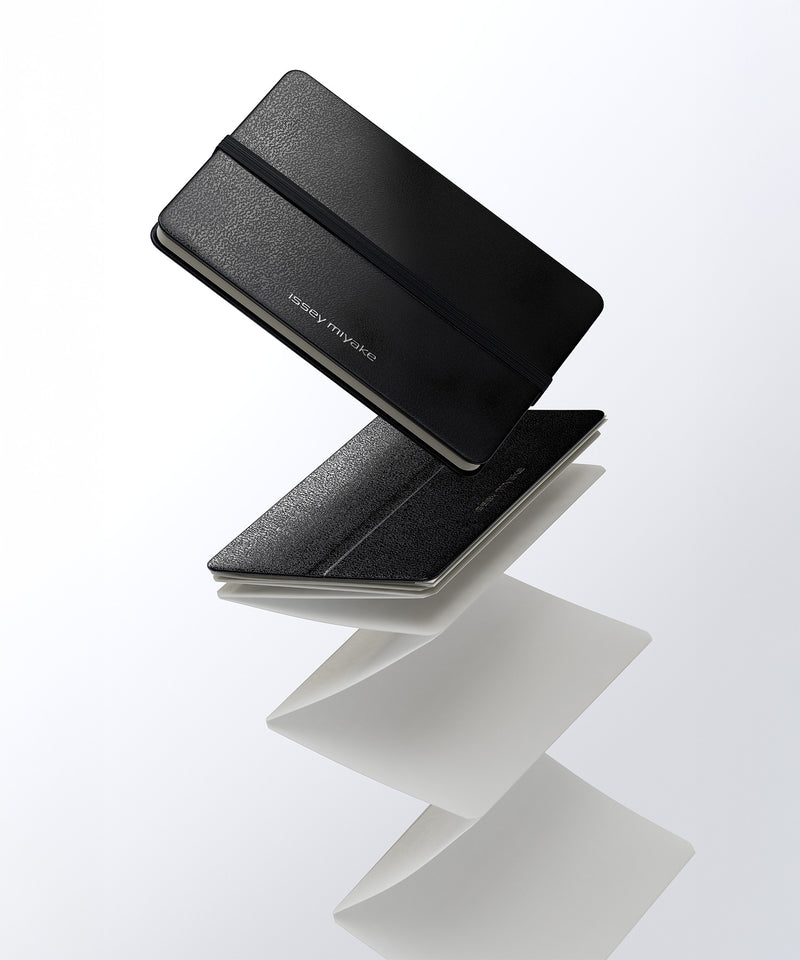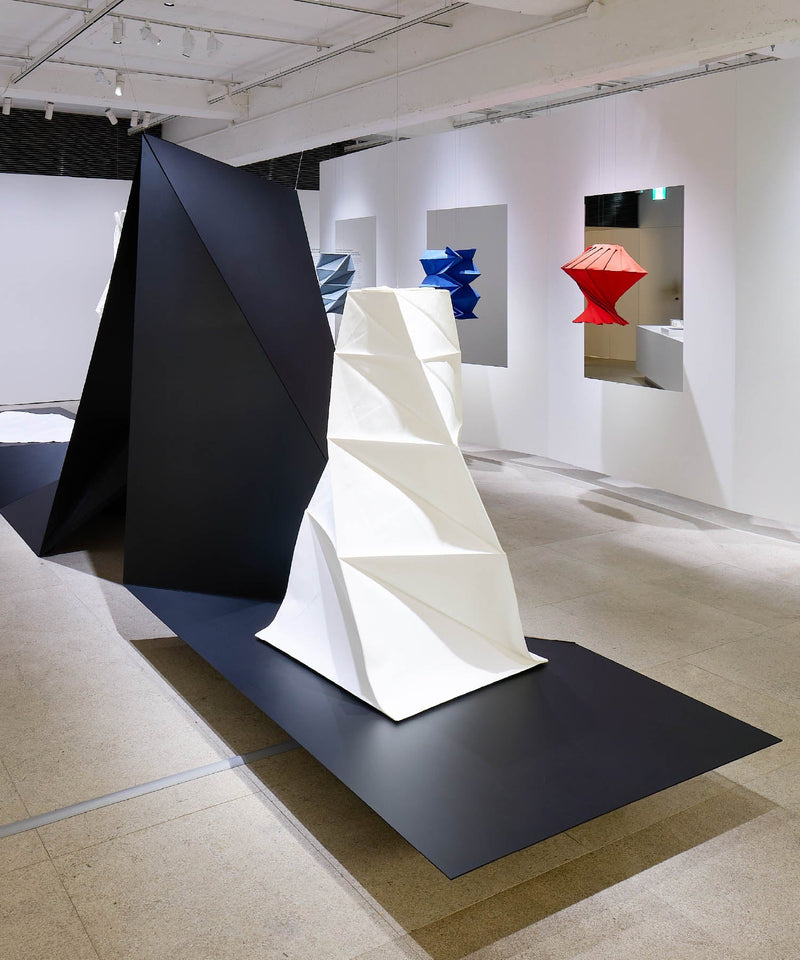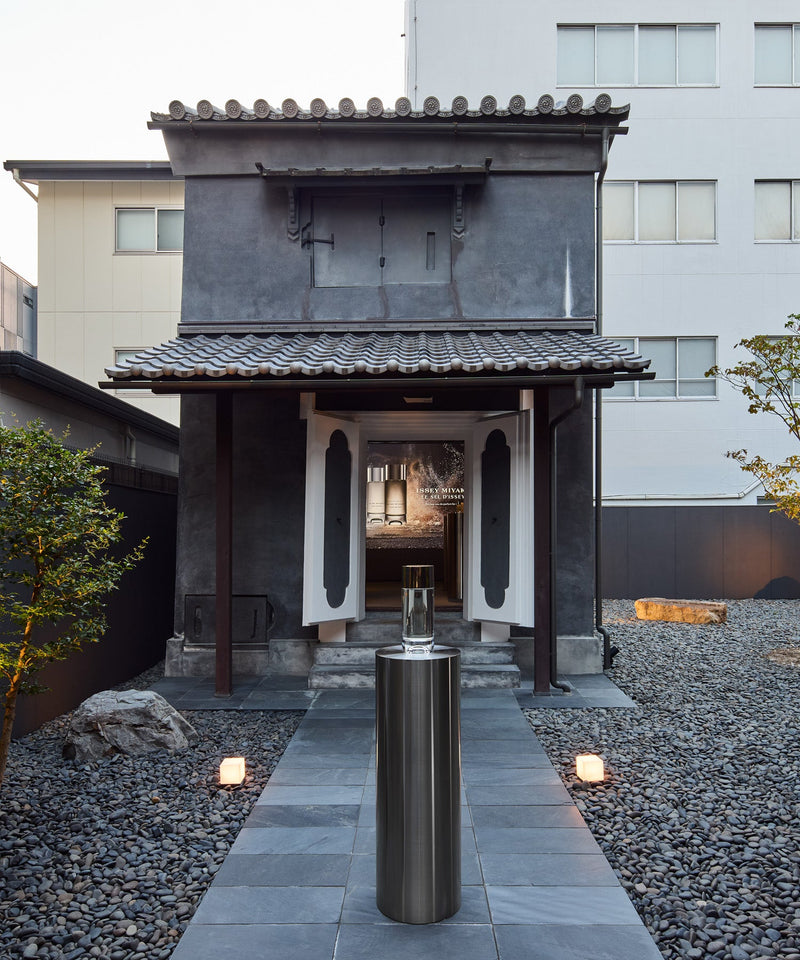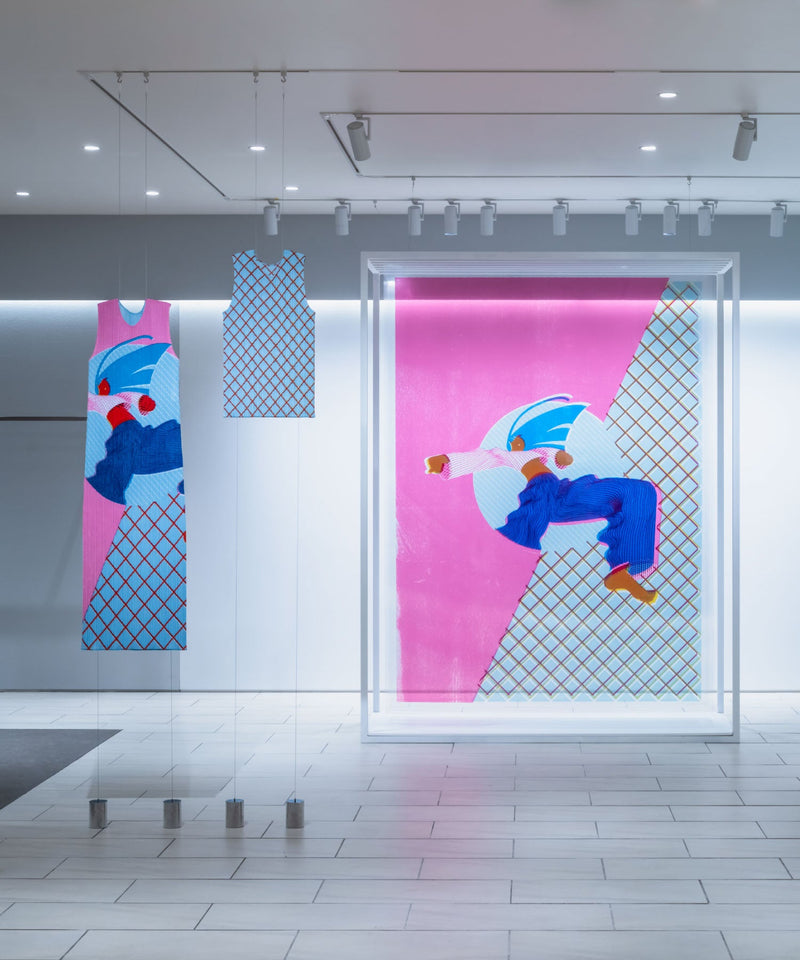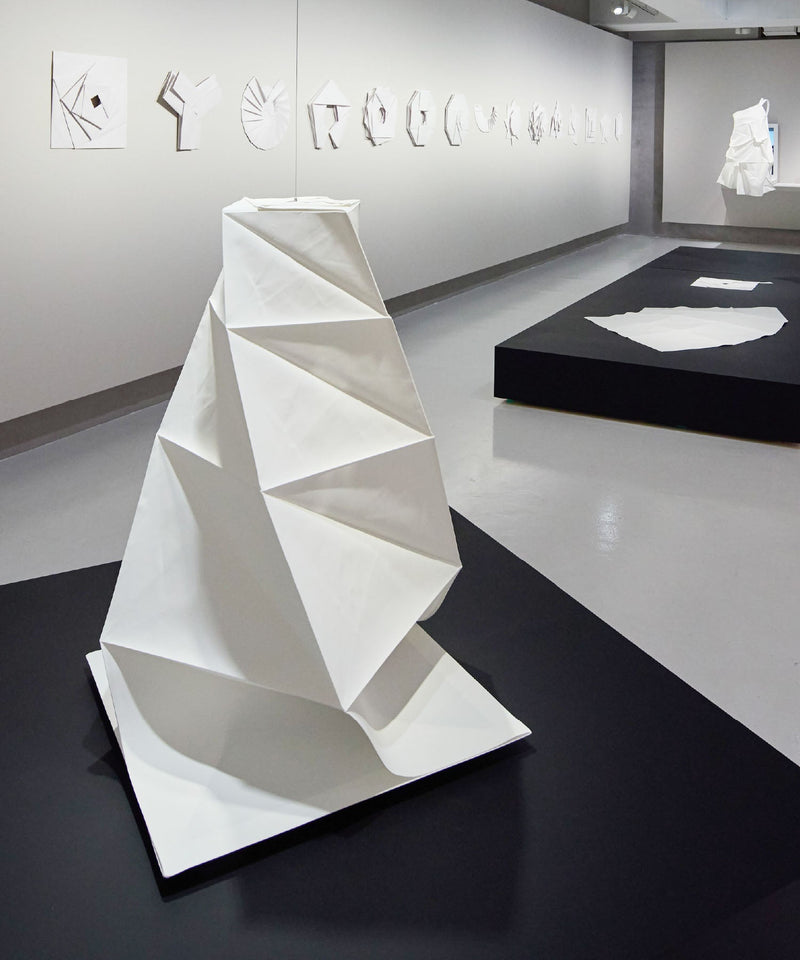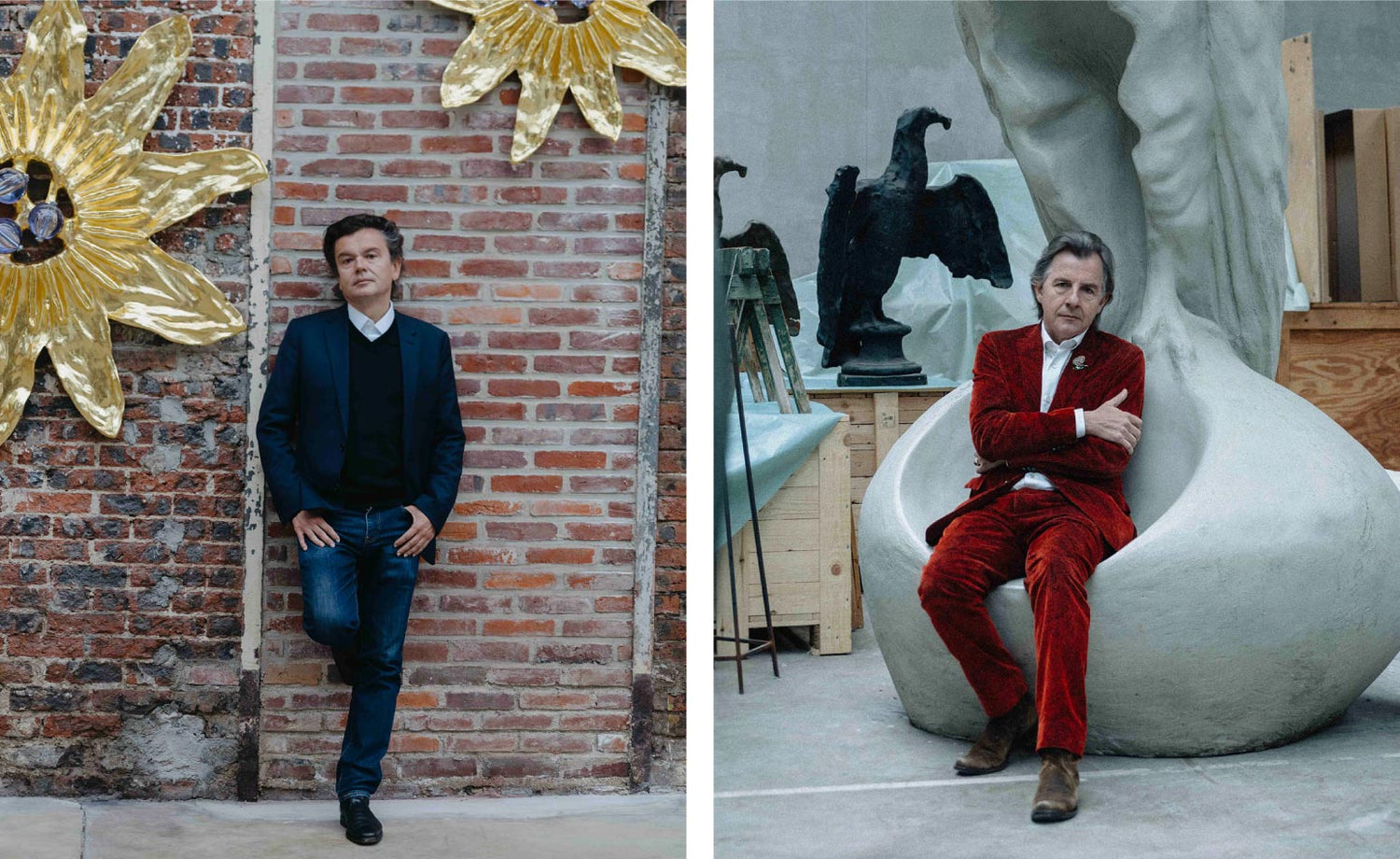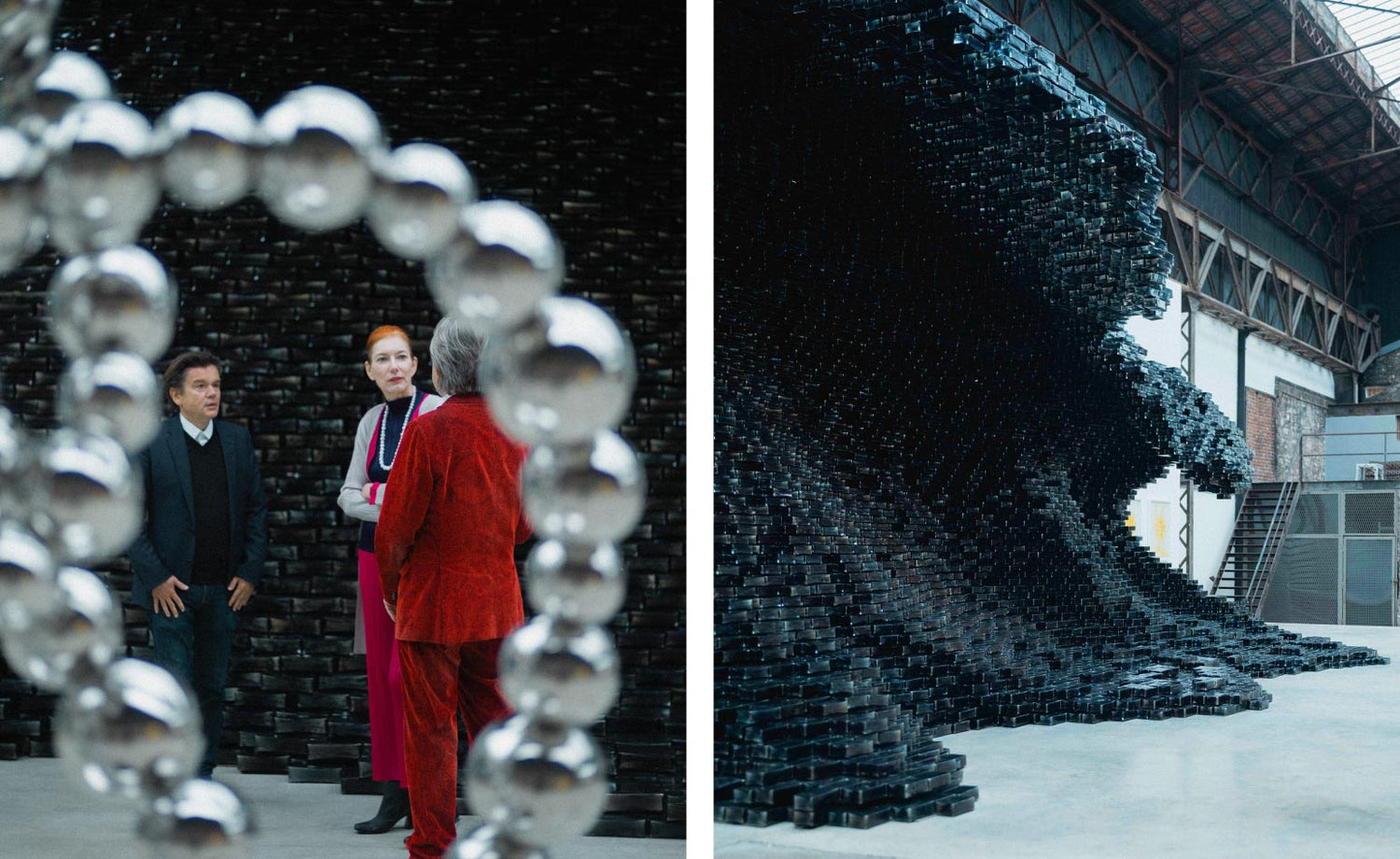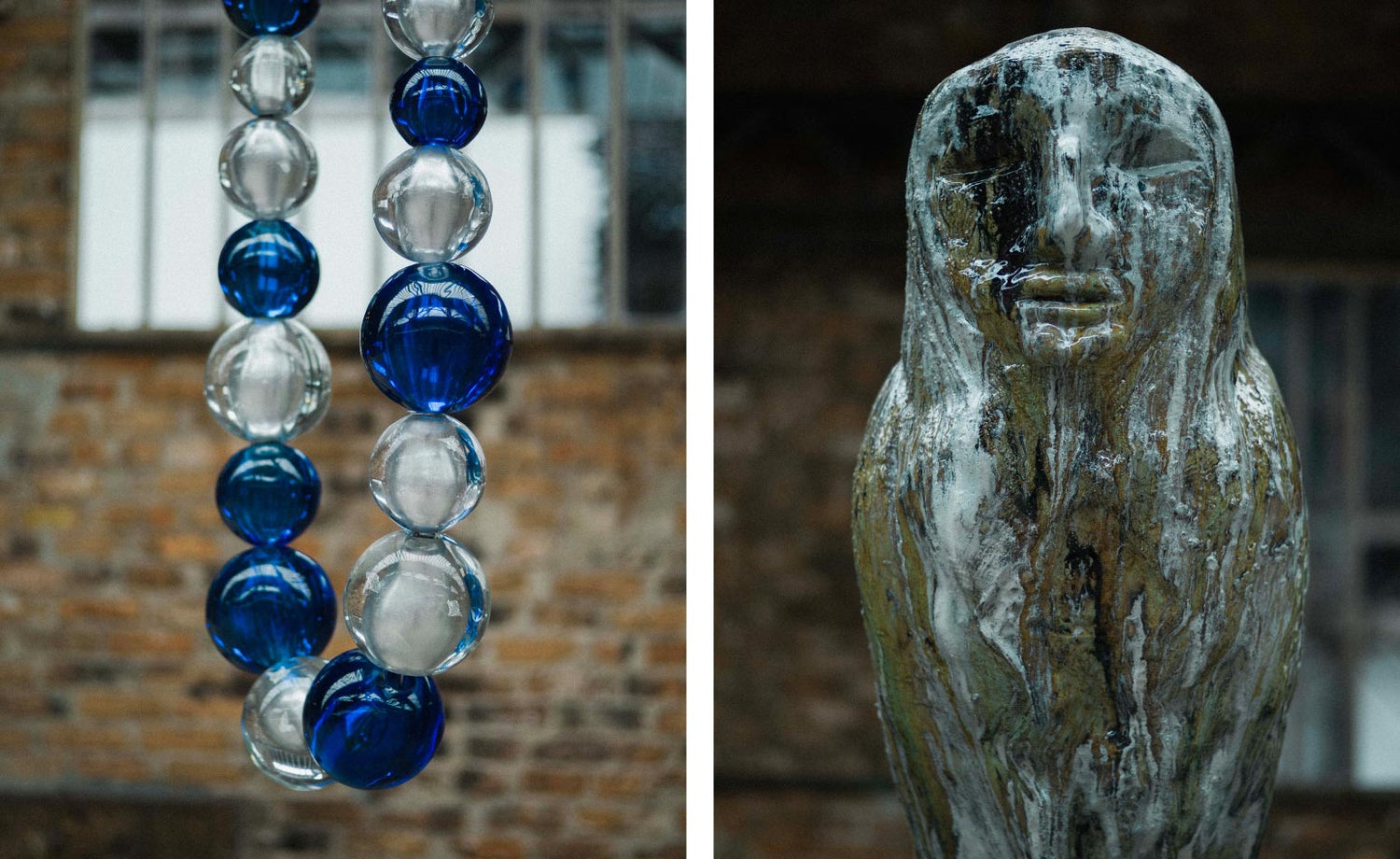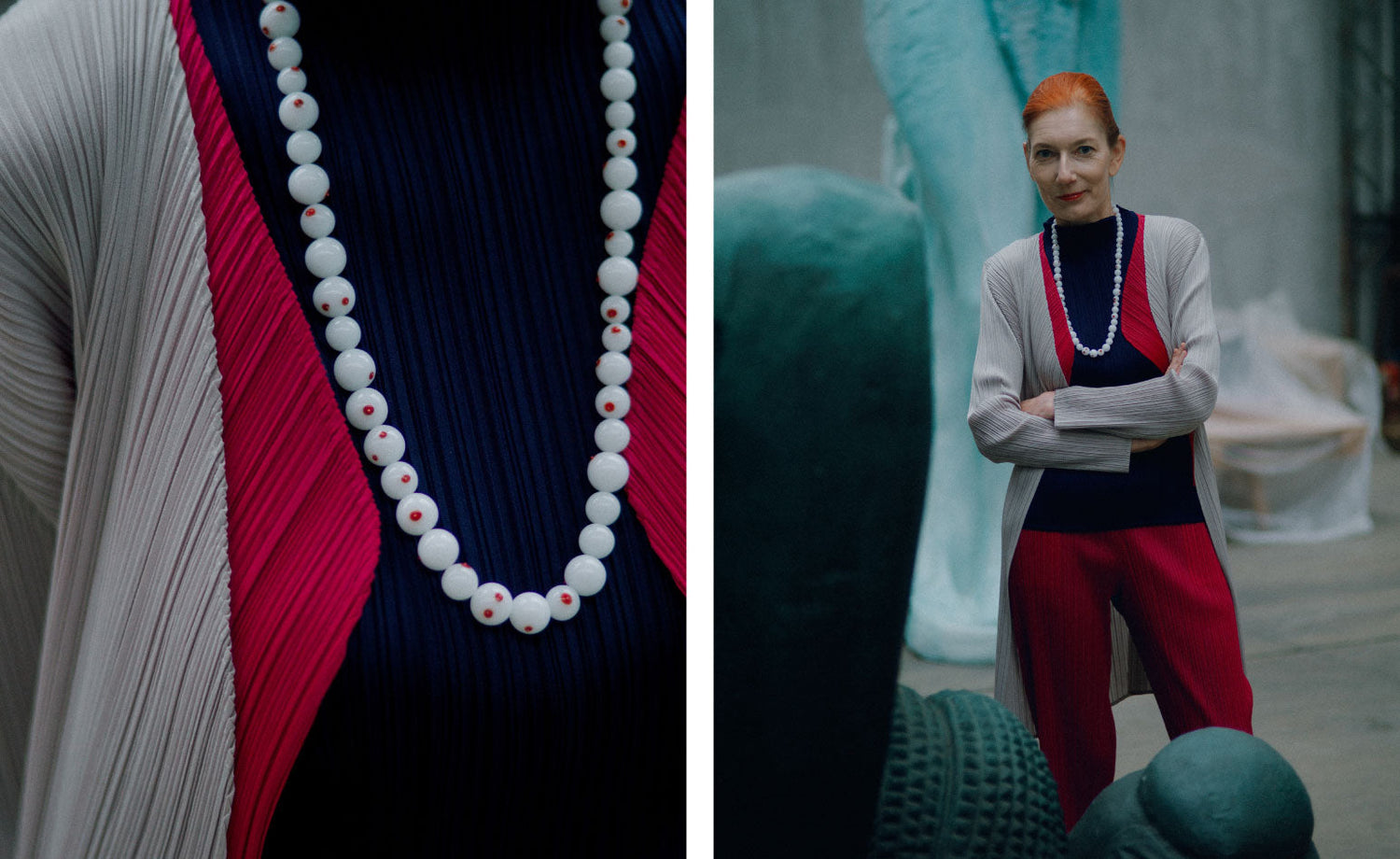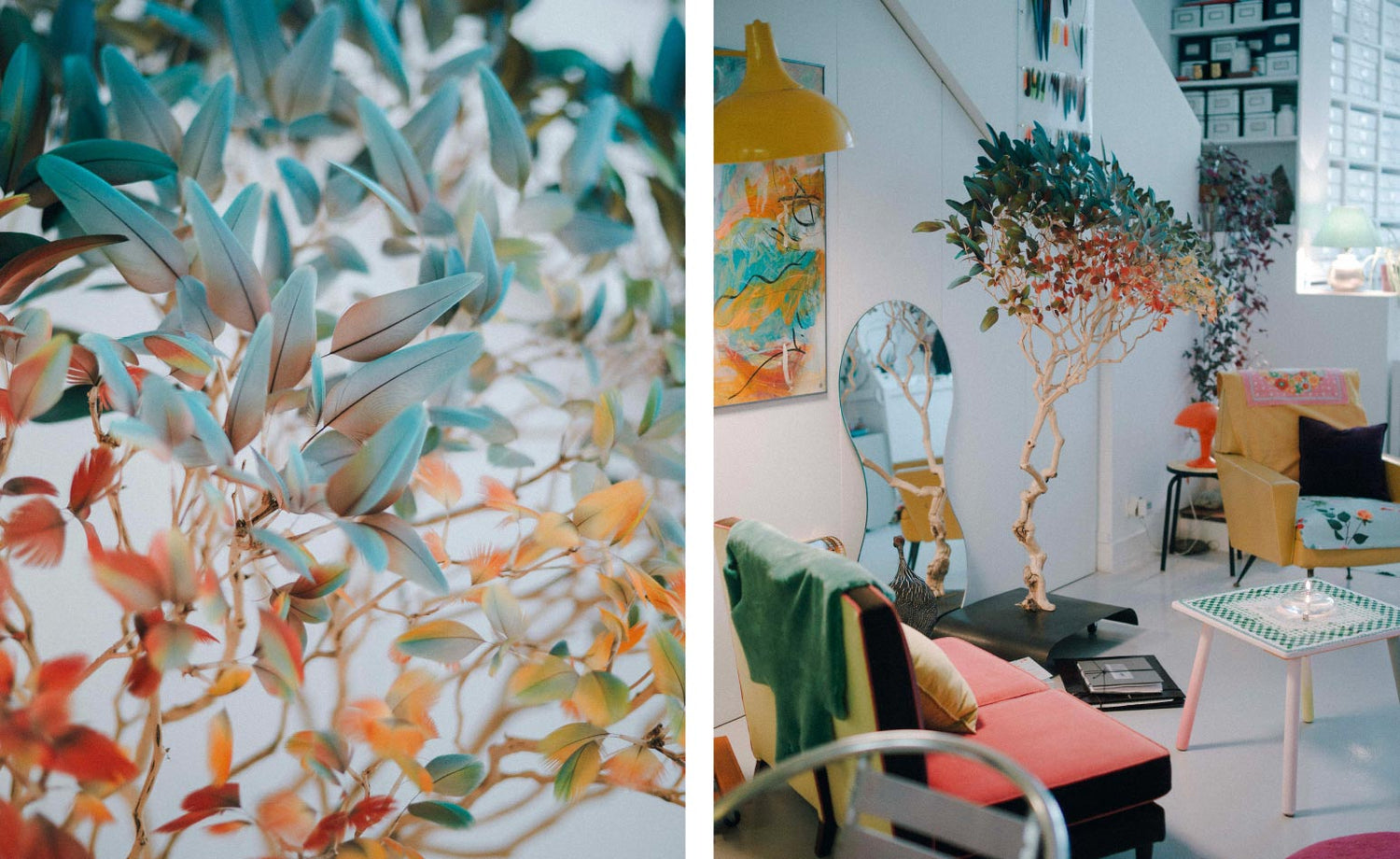A day in the life of Hélène
With PLEATS PLEASE
Final: Friends from Paris
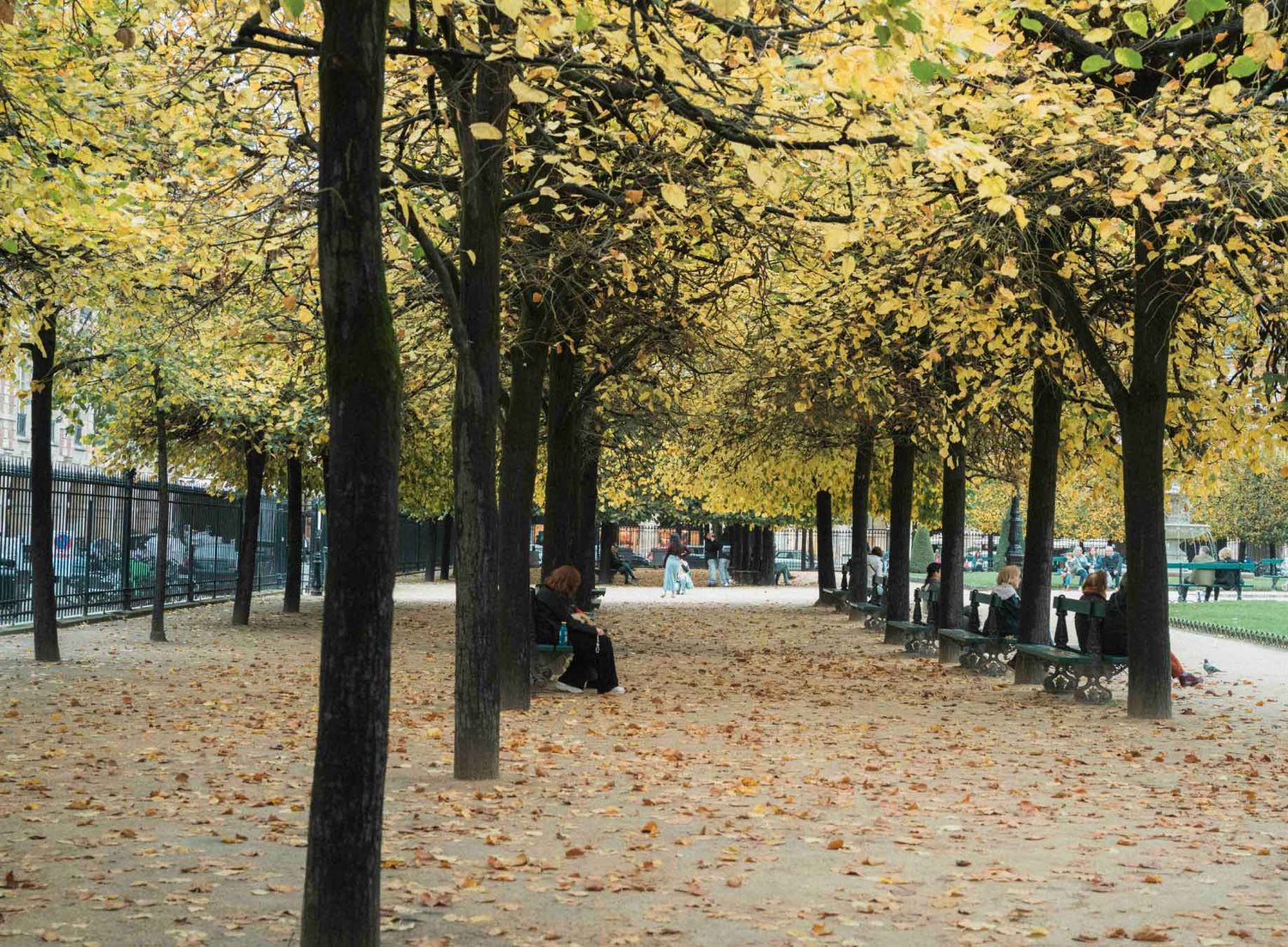
Her name is Hélène Kelmachter.
It is October, and Hélène has traveled to Paris on a business trip. During her busy schedule, she finds time to meet up with old friends.
The five artists warmly invite her to their studios and homes. Her friends are creators, each with a different field of endeavor. It is a priceless opportunity to see their new works and talk about future projects.
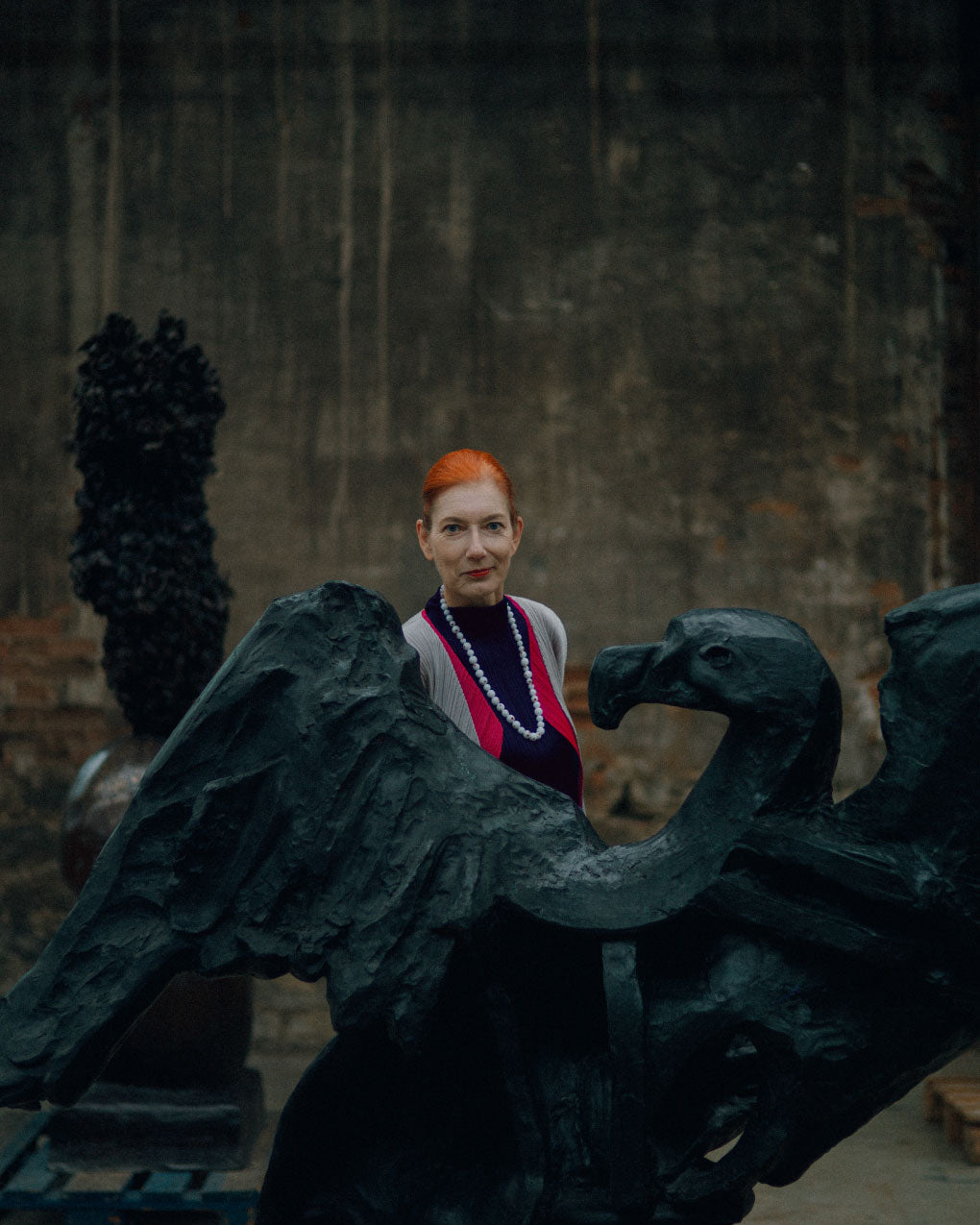
Hélène and The Price of Freedom, 2015, patinated bronze.
Day one.
Montreuil, in the suburbs of Paris. Hélène visits “La Solfatara,” a studio shared by two artists, Jean-Michel Othoniel and Johan Creten.
The name comes from the word for fumarole, an opening in a volcano that emits volcanic gas. The scale of the space is every bit as overwhelming as one would expect. It is big enough that Othoniel can install giant sculptures like “The Big Wave” from glass bricks, inspired by Katsushika Hokusai’s “Great Wave off the coast of Kanagawa.”
Jean-Michel Othoniel is one of France’s leading artists, known for a series of sculptures that string together colorful glass pearls to depict space as a complex arabesque. The work invites the viewers on a journey of discovery, the light carefully directed, and the viewer and surroundings reflected in the glass.
Johan Creten is at the forefront of incorporating pottery into contemporary art. He creates sculptures from ceramics and bronze that are gigantic, but at the same time intimate. Animals, strange insects, bodies covered with delicate flowers, scenes that feel straight out of mythology and fables. It is a mystical world, but at the same time inviting.
The two artists create completely different work, but they respond to each other and share a lyrical dimension. They seem to be frolicking in a broad, endless space. The studio is a place of creativity, but also a space in which to display their works and welcome collectors and curators from around the world. It also, unusually, has an artist residency.
The visit comes right in the middle of “Art Basel Paris 2024,” and the artists are busy. They go out of their way to welcome Hélène. Johan offers coffee and tea in a small café space at the entrance to the studio, while Jean-Michel arranges dahlias and calla lilies in a glass vase.
Hélène says, “I first met Jean-Michel and Johan more than 20 years ago.”
“I curated two solo exhibitions with Jean-Michel: the first one in Paris at the Fondation Cartier pour l’art contemporain, and then in Buenos Aires. His work was always stimulating, and it was also a joy to write some texts about his creations.
“He held several exhibits in Japan, and some of his works are on permanent display around the country in places like Karuizawa, Gunma and Tokyo. His monumental “The Big Wave” is so closely tied to Japanese culture that it would be wonderful to see it in Japan and have it permanently displayed there.”
“I have not yet had the opportunity to work with Johan, but it has been my dream to do so ever since I viewed a solo exhibit of his in Rome several years ago. How wonderful it would be to curate an exhibition of the two of them!”
Day 2.
Hélène visits the atelier of Nelly Saunier in a quiet Parisian neighborhood.
It is a typical Parisian atelier. The ceiling is more than five meters high. There are large windows to let in the light. The white space features a white worktable, shelves, driftwood, and stones collected from travels around the world, but what really catches the eye are the colorful feathers. Feathers are both her inspiration and the material of her works.
Nelly is a feather artist. She began down this road at the age of 14 and is widely considered to be the leader in the field. In 2008, she was distinguished as “Maître d’Art,” the most prestigious crafts title in France.

Feathercraft has been practiced in France since the thirteenth century. It reached its peak in the 1920s, after which the scale of production gradually waned. Today, it is enjoying a resurgence as a rare form of art.
Nelly knows all there is to know about how to work with feathers, their structures, and the individual details of each. Her works are precise, tactile, and imbued with a poetic light. They communicate the unbounded potential of this material.
She often receives commissions from haute couture, movie costume designers, and top-tier jewelry Maisons. The works she creates for them are breathtakingly detailed, and they are all put together in this atelier. She also creates personal works that share her aesthetic and clearly express her worldview of “creating re-created nature.”
It is a long time since the two have met, and their conversation is lively and enthusiastic.
“I first met Nelly in 2017 when I was curating the exhibition “Wonderlab, The Living Treasure of France” for the Tokyo National Museum.
“I was immediately moved and attracted by her talent and invited her to join the project together with 14 other masters. I had been working in the field of contemporary art, and it was a wonderful opportunity for me to explore the richness and creativity of crafts for the first time. The exhibit was a journey through beauty and an artistic moment, but it was also a human experience.
“Nelly has a unique technique of re-creating and re-inventing nature, and I hope to have the opportunity to collaborate again with her to share her talent with many more people.”
Day 3.
Hélène rings the bell on a red door facing a quiet street in southeastern Paris. She is with her daughter, Séléna, who is excited about seeing close friends of both of them who live in this beautiful house.
They are greeted by botanist Patrick Blanc and musician Pascal Héni.
Patrick studies tropical rain forests at CNRS (French National Centre for Scientific Research) and has discovered many new species. He is best known, however, as the inventor of the “vertical garden,” a wall covered in numerous varieties of plants. He has been involved in more than 300 projects around the world and continues to work with those currently in progress while also getting out into the field in the jungles of Southeast Asia, Africa and South America.
You can see his vertical gardens in Japan at the 21st Century Museum of Contemporary Art, Kanazawa and the Shin-Yamaguchi train station.
Pascal is a singer, musician, composer and Indian superstar. He is deeply involved in Indian cinema, has released an album of hit songs from Indian movies, and had nationwide tours and television appearances that earned him the nickname, “Pascal of Bollywood.” Multitalented, he often accompanies Patrick on his travels and has filmed several documentaries of the fieldwork.
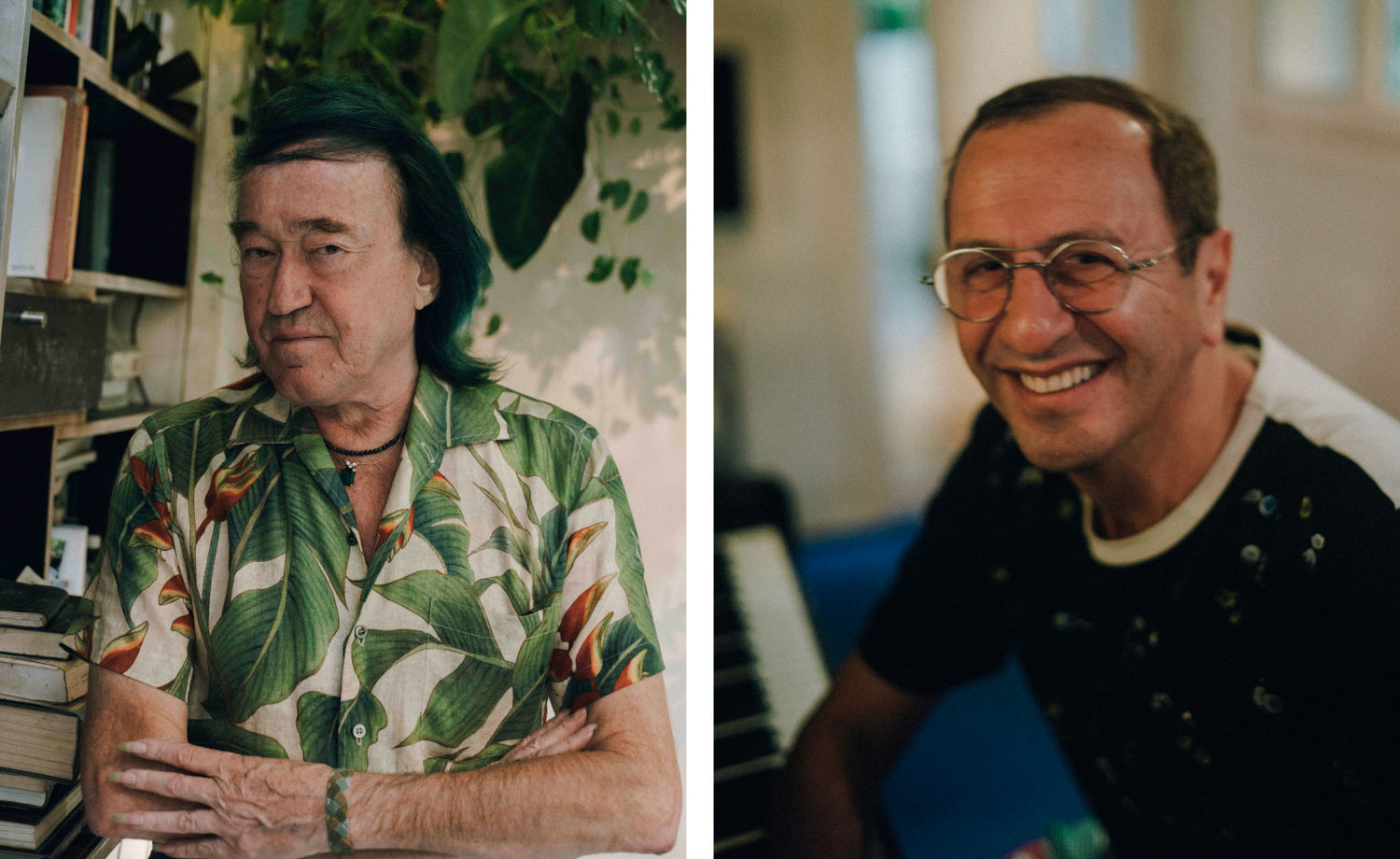
The two-story house is built around a courtyard and full of surprises, the most impressive of which is Patrick’s workspace.
On two walls, stretching from the first floor to the ceiling of the second, are vertical gardens with roughly 160 varieties of tropical plants and colorful birds flying near the top. The glass floor where his desk is situated is a giant aquarium with more than 2,000 fishes. It is a musical environment filled with the songs of birds from above and the sound of water from below.
The library contains plant encyclopedias and books from around the world, guidebooks and souvenirs from almost every city, and old film and concert posters that round out the interior.
Given the amount of traveling the two do, the house must feel like an oasis into which they can pour their enthusiasm and passions. The four converse over a favorite rose wine.
“I met Patrick and Pascal in 1998. It was at the time of the ‘Etre Nature’ exhibit at the Fondation Cartier pour l’art contemporain. On the occasion of that exhibition, Patrick created the vertical garden above the entrance to the Fondation Cartier that was designed by Jean Nouvel. It still greets visitors today.
Several months later, Pascal performed a concert inspired by Dante’s Divine Comedy for one of the Nomadic Nights during the ‘ISSEY MIYAKE: Making Things’ exhibit. That was the start of our friendship.
“Séléna has loved visiting their home since she was a small child. She was attracted by Patrick’s green world and loves Pascal’s Bollywood music, which she often shares with her friends.”
In his workspace, Pascal Héni sits at the piano and plays the song he composed for the “ISSEY MIYAKE: Making Things” exhibit held at the Fondation Cartier pour l’art contemporain in Paris in 1998.
It was after that exhibit that Hélène began to wear Issey Miyake almost exclusively. The first PLEATS PLEASE she purchased was a dress from the “Guest Artist Series” by Tim Hawkinson who participated in the exhibit. Twenty-six years later she still enjoys wearing it.
“I remember my first impression wearing PLEATS PLEASE. It was very light and comfortable, and it followed my movements. It was completely liberating, and that freedom is one of the things I value most in my life.”
During her short visit to Paris, Hélène wore PLEATS PLEASE ISSEY MIYAKE BASICS and NEW COLORFUL BASICS to visit her five artist friends.
Hélène was 14 years old when she decided that she wanted to work in the world of art and have artists in her life.
She continues to pour her energy into sharing beauty with people.
Obviously, wearing PLEATS PLEASE.
Worn by: Hélène Kelmachter, Séléna Kelmachter—Styling by Hélène and Séléna.
Accessories, bags, and other small items are from her personal wardrobe.
Photography: Kazumasa Harada
Hair and make-up: Hiroyuki Fuwa
Composition: Tamaki Harada + Mari Nakayama|Cawaii Factory
Concept and direction: Midori Kitamura










